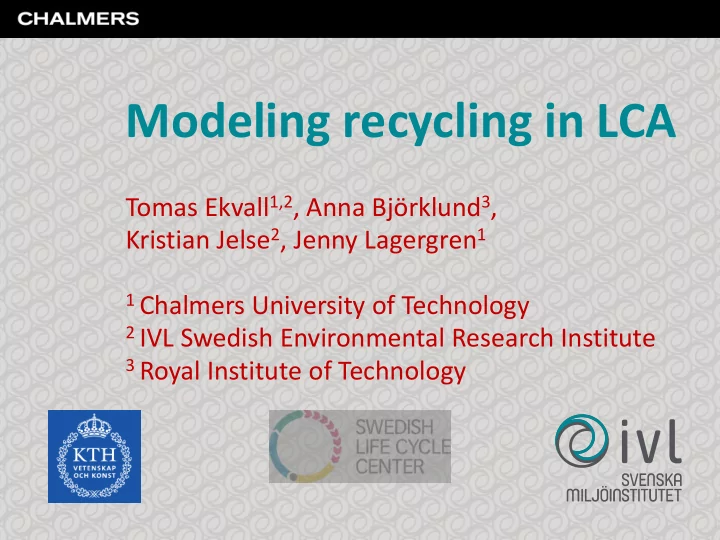

Modeling recycling in LCA Tomas Ekvall 1,2 , Anna Björklund 3 , Kristian Jelse 2 , Jenny Lagergren 1 1 Chalmers University of Technology 2 IVL Swedish Environmental Research Institute 3 Royal Institute of Technology
Highlights 1. Criteria for good LCA methods 2. Assessment of various approaches to allocation at recycling 3. Swedish consensus process will follow www.lifecyclecenter.se
Source: Domenech 2019 www.lifecyclecenter.se
Source: Ekvall et al. 2019 www.lifecyclecenter.se
Standards Guidelines Scientific publications ISO 14044 + TR 14049 PEF & OEF Ekvall & Tillman (1997) ISO 14067 International EPD Ekvall (2000) ISO 20915 Nordic Guidelines on LCA Schrijvers et al. (2016) EN 15804 + TR 16970 Dutch Handbook on LCA Allacker et al. (2017) EN 16485 UBA guide on packaging LCA PAS 2050 Greenhouse Gas Protocol Worldsteel Association & ISSF Ecoinvent => 12 main approaches www.lifecyclecenter.se
Circular Footprint Formula E = (1-R 1 )×E V +R 1 × [ AE Rin +(1-A)E V ×Q Sin /Q P ] + + (1-A)R 2 ×[(E Rout -E* V × ( Q Sout /Q P )] + + (1-R 2 )×E D www.lifecyclecenter.se
Criteria – starting point LCA should contribute to reducing environmental impacts www.lifecyclecenter.se
Previously derived criteria Feasible Accurate results Compre- hendible information Inspiring Robust knowledge decisions incentive abuse Source: Ekvall et al. 2004 www.lifecyclecenter.se
Easily applied Our criteria Feasible Available data or indicators Generalizable results Close to reality Accurate Life cycle scope Explicit, justified, evaluated Reduce impacts Comprehendible Comprehendible Relevant Inspiring Legitimate Reproducable Robust Adaptable Source: Ekvall et al. 2019 www.lifecyclecenter.se
F. Explicit, justified, and evaluated Tentative D. Sufficiently close to reality B. Readily available data C. Generalizable results assessment G. Comprehendible E. Life cycle scope J. Reproducible results A. Easy to use I. Legitimate K. Adaptable H. Relevant Criteria Method Simple cut-off Cut-off with economic allocation Cut-off plus credit Allocation to material losses Allocation to virgin material use 50/50 methods Quality-adjusted 50/50 methods Circular Footprint Formula Market price-based allocation Market price-based substitution Price-elasticity approaches Allocation at the point of substitution www.lifecyclecenter.se
The project continues … • Case studies in industry (ongoing) • Revised assessment • Consensus process www.lifecyclecenter.se
Funding: Swedish Energy Administration Re:Source Programme Coordination: Consortium Swedish Life Cycle Center Case-study partners: Extended working group: Essity SSAB Research group: Outokumpu Chalmers University of Technology Volvo IVL Swedish Environmental Research Institute Tetra Pak Royal Institute of Technology RISE/Miljögiraff Vattenfall Jernkontoret Volvo Cars Swedish Environmental Protection Agency Nouryon Swedish Transport Administration Stena Recycling www.lifecyclecenter.se
Thanks for the attention! Sources: Allacker K, Mathieux F, Pennington D, Pant R. 2017. The search for an appropriate end-of-life formula for the purpose of the European Commission Environmental Footprint initiative. Int. J. LCA 22:1441- 1458. Domenech T (2019) Explainer: What is a circular economy? The Conversation. https://theconversation.com/explainer-what-is-a-circular-economy-29666 Ekvall T (2000) A market-based approach to allocation at open-loop recycling. Resources, Conservation and Recycling 29(1-2):93-111. Ekvall T, Tillman A-M (1997) Open-loop recycling: criteria for allocation procedures. Int. J. LCA 2:155- 162. Ekvall T, Ciroth A, Hofstetter P, Norris G (2004) Comparative assessment of attributional and consequential methods for LCA. Poster och PM från 14th Annual Meeting of SETAC-Europe, Prag, Tjeckien, april 2004. Abstracts p. 197. Ekvall T, Björklund A, Jelse K (2019) Modelling recycling in life cycle assessment ***incomplete draft***. Swedish Life Cycle Center, Gothenburg, Sweden. Schrijvers DL., Loubet P, Sonnemann G. 2016. Critical review of guidelines against a systematic framework with regard to consistency on allocation procedures for recycling in LCA. Int. J. LCA 21(7): 994-1008. www.lifecyclecenter.se Kontact: tomas.ekvall@ivl.se
Recommend
More recommend